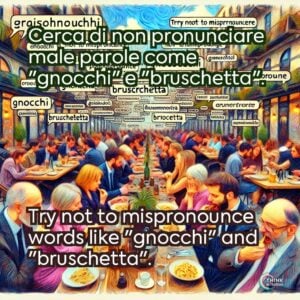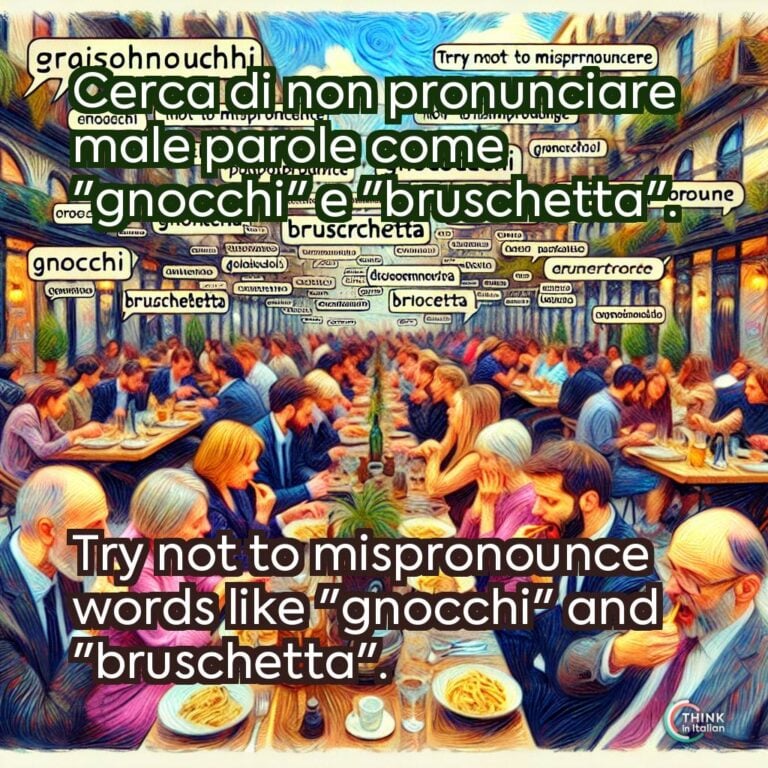Italian is one of the most spoken languages in the world which attracts millions of language learners every year.
Most of its words are universally known – think of pasta, amore, buongiorno – yet some of them are mispronounced or changed to adapt to the phonetics of other languages.
Italian phonetics is overall quite easy, but there are some sounds that might not exist or be pronounced differently in other languages. Here I will give you an overview of the trickiest sounds you may encounter when reading Italian words:
- gn: This sound is very similar to the Spanish ñ or the English ny as in “Canyon”. It is produced by placing the middle part of your tongue against the hard palate, just behind your upper teeth. Its pronunciation is consistent throughout all vowels.
- Examples: lasagna, bagno (toilet), gnomo (gnome).
- gl: This sound is very similar to the Spanish ll. It is produced by placing the tip of your tongue against the hard palate, right behind your upper front teeth. It is used with the vowel i only.
- Examples: famiglia (family), maglia (t-shirt), aglio (garlic).
- ch: This is the k sound. In Italian it is always followed by the vowels i or e, and it is produced in the same way as when you pronounce Italian words with the letter c followed the other vowels. The only difference is that with the vowels i or e you must graphically use the letter h.
- Examples: chiesa (church), chiave (key), but also casa (house), corpo (body), cuore (heart).
- gh: Same as above. It is always followed by the vowels i or e but it is produced in the same way as when you pronounce Italian words with the letter g followed the other vowels. The only difference is that with the vowels i or e you must graphically use the letter h.
- Examples: ghiaccio (ice), ghepardo (cheeta), but also gatto (cat), mago (magician), guanti (gloves).
- g+i/e: This is the same sound as the English j as in “jam”. It is produced by placing the tongue against the roof of the mouth, just behind the upper front teeth, and by letting your vocal chords vibrate.
- Examples: gelato (ice cream), giraffa (giraffe)
- c+i/e: This is the “ch” sound as in the English word “chocolate”. It is produced by placing the tongue against the roof of the mouth, just behind the upper front teeth, without the vibration of your vocal chords.
- Examples: cielo (sky), cena (dinner)
- sc+i/e: This is the “sh” sound as in the English word “sheep”. It is produced by placing the tip of the tongue near the front of the roof of the mouth and by letting the air pass through. When followed by the other vowels, sc sounds like the “sk” sound as in the English word “school”.
- Exampled: sciare (to ski), scena (scene), but also scala (staircase), scopa (broom), scusa (excuse).
Mispronounced Italian Words
- Bruschetta: this is one of the most mispronounced Italian words. Now you should know that its correct pronunciation is “broo-sket-ta”.
- Prosciutto: another commonly mispronounced Italian word, which should be pronounced as “pro-shoot-oh”.
- Cappuccino: its correct pronunciation is “cah-poo-chee-no”.
- Pistacchio: this word is pronounced as “pee-stahk-yo”.
- Gnocchi: I admit that this is a hard one. It should be pronounced as “nyo-kee”.
- Focaccia: another word that frequently gets mispronounced, whose proper pronunciation is “foh-kah-cha”.
Tips for Improving Your Italian Pronunciation
Listen to Native Speakers
One of the best ways to improve your Italian pronunciation is to listen to native speakers. This will help you get a sense of the rhythm and intonation of the language. You can listen to Italian music, watch Italian movies or TV shows, or even find a language exchange partner to practice with.
Practice Regularly
Something that I like doing, although it might seem crazy, I know, is to speak to myself in front of a mirror. This way I can see my mouth moving and I have a clearer sense of how and where the sound comes from.
Like any skill, improving your Italian pronunciation requires practice. Set aside time each day to practice speaking Italian, even if it’s just for a few minutes: read Italian texts out loud, repeat phrases after native speakers, or record yourself speaking and listening back to them.
Ready to Speak Fluently
Italian is a beautiful language that is full of passion and emotion, and proper pronunciation is essential for anyone looking to master the language.
By following the tips outlined in this article, you can improve your Italian pronunciation and impress your friends and colleagues with your newfound skills. Remember, practice makes perfect, so don’t be afraid to make mistakes and keep practicing until you get it right.






